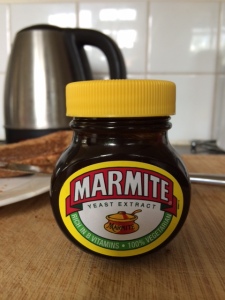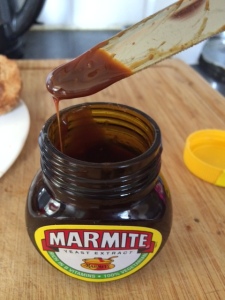I remember missing hummus during my long months in Italy. I kept telling myself “what are you complaining about? Italian food is amazing.” Yes, undoubtedly true, although what I missed was obviously not just hummus, but the wide choice that London has to offer in terms of different products and cuisines. This testifies how travelling changes our own way of thinking and in this case eating, opening our minds to new food adventures.
For example with the exception of Nutella,I personally never considered spreads as fundamental. Yes, the occasional peanut butter on toast once in a while, but never a necessary pantry staple. Last week while I was pushing my trolley in a busy aisle of my local supermarket I saw Marmite, the British yeast spread, and something happened in my mind.
When I was in Australia 3 years ago I tried Vegemite, the Australian yeast spread, because I was curious about the flavour. “You can either hate or love it, there’s no middle ground” I was told. These words sounded like a challenge I had to take up, so I gave Vegemite a go and I ended up really liking it. So when I saw Marmite, its British opponent, on the supermarket shelf I knew I had to try it see for myself how different it was. Also to discover which side I have to take during the heated arguments between my British and Aussie friends on which spread is the best.
Before I start, for those of you who might wonder why anyone should eat a yeast spread, you will be surprised to know that both Marmite and Vegemite are rich in Vitamin B and folate.
My personal test:
Vegemite:
- Colour: dark chocolate brown.
- Aspect: thick almost jelly-like, in fact it doesn’t drip when trying to take a little quantity out with the butter knife.
- Aroma: first mouldy, because of the yeast, and then you can smell traces of monosodium glutamate.
- Flavour: extremely salty and of course yeasty because yeast is the main ingredient. Although Vegemite’s recipe includes spices and vegetable extracts, in my opinion they are not so strong to balance the combination of yeast and salt, that I would define overpowering .
- How to eat it: Aside from the classic Vegemite toast (toasted bread, butter and a thin layer of Vegemite) and its variations, I would add it to stews or soup to give these recipes a nice umami kick.
Marmite:
- Colour: burnt caramel
- Aspect: runny, it reminds caramel sauce or dulce de leche both for colour and texture.
- Aroma: Yeasty as Vegemite but less strong in glutamate.
- Flavour: As predicted by my nose, Marmite is less salted than its Australian opponent. After the savoury note comes the aftertaste which is slightly bitter, due to a combination of yeast, vegetable extracts and spices that, here in Marmite, I can definitely taste.
- How to eat it: like Vegemite, on toast, but I would rather use it for the preparation of soups or stews because of its aftertaste that reminds stock cubes.
Yast spreads, you either love or hate them. I my case I ate them and my impartial choice is: Vegemite!
*In the meantime my auntie and my cousin came for a couple of days and I gave them a Marmite toast telling them it was a sweet spread like Nutella, just because I am evil and wanted to see their reactions. Both were surprise by the unexpected flavour but while my cousin was nauseated, my auntie loved it.
And now in Italian.
Ricordo che durante i miei lunghi mesi in Italia mi mancava l’hummus. Continuavo a ripetermi “ma di cosa ti lamenti? Il cibo italiano è tra i migliori del mondo .” Sì, indubbiamente vero, anche se quello che mi mancava davvero non era solo l’hummus, ma l’ampia scelta che Londra ha da offrire in termini di prodotti e cucine diverse. Questo testimonia come viaggiare cambi il nostro modo di pensare e in questo caso mangiare, aprendo le nostre menti a nuove avventure gastronomiche.
Ad esempio, con l’eccezione di Nutella, non ho mai considerato fondamentali le creme spalmabili. Sì, il burro di arachidi sul pane tostato una volta ogni tanto, ma non l’ho mai considerato un prodotto da non farsi mai mancare in dispensa. La settimana scorsa, mentre stavo spingendo il mio trolley in un corridoio affollato del supermercato vicino casa, ho visto la Marmite, una crema spalmabile a base di lievito, e qualcosa è scattato nella mia mente.
Mi spiego meglio, quando ero in Australia tre anni fa ho provato la Vegemite, la crema spalmabile australiana a base di lievito, perché ero curiosa provarla dopo che avevo sentito più volte ripetere: “O si ama o si odia, non c’è via di mezzo”. Queste parole suonavano come una sfida che dovevo accettare, così ho dato un’occasione alla Vegemite e devo dire che mi è piaciuta. Così quando ho visto la Marmite, il suo competitor britannico sullo scaffale del supermercato, sapevo che dovevo provare questo prodotto. Anche per scoprire da quale parte stare durante le accese discussioni tra i miei amici britannici e australiani su quale delle due creme sia la migliore.
Prima di cominciare, a quelli che si chiedono perché mai dovremmo mangiare una crema spalmabile a base di lievito, rispondo che sia la Vegemite sia la Marmite sono ricche di vitamina B e acido folico.
Il mio test:
Vegemite:
- Colore: marrone scuro come il cioccolato fondente.
- Aspetto: denso, quasi gelatinoso. In fatti non cola quando si prende con il coltello.
- Aroma: si sente un odore quasi ammuffito, per via del lievito, e delle tracce di glutammato monosodico.
- Sapore: estremamente salato con retrogusto amaro di lievito, ovviamente perché è l’ingrediente principale. Sebbene la ricetta di Vegemite comprenda spezie ed estratti vegetali, a mio parere non sono così forti da bilanciare la combinazione dominante di lievito e sale.
- Come mangiarla: parte il classico toast con Vegemite (pane tostato, burro e un sottile strato di Vegemite) e le sue varianti, personalmente aggiungerei il prodotto a zuppe e stufati per dare un pizzico di umami al piatto.
Marmite:
- Colore: caramello bruciato
- Aspetto: meno densa rispetto alla Vegemite, infatti cola dal coltello. Ricorda salsa al caramello o il dulce de leche, sia per il colore e la consistenza.
- Aroma: odora di ievito come la Vegemite, ma risulta meno forte in glutammato.
- Sapore: Come previsto dal mio naso, la Marmite è meno salata rispetto al suo competitor australiano. Dopo la sapidità arriva il retrogusto leggermente amaro, a causa di una combinazione di lievito, estratti vegetali e spezie che, qui nella Marmite, si sente decisamente di più.
- Come mangiarla: come Vegemite, sul pane tostato, ma piuttosto la utilizzerei per la preparazione di minestre o stufati a causa del suo retrogusto che ricorda dadi da brodo.
Vegemite o Marmite, o si amano o si odiano. Nel mio caso si amano e la mia scelta è imparziale: Vegemite!
* Nel frattempo, mia zia e mia cugina sono venute a trovarmi per un paio di giorni e ho approfittato per provare loro la Marmite dicendo loro che era una crema spalmabile dolce come la Nutella, solo perché sono cattiva e volevo vedere le loro reazioni. Entrambi erano sorprese dal sapore inaspettato ma mentre mia cugina era letteralmente disgustata, a mia zia mi è piaciuto molto.


